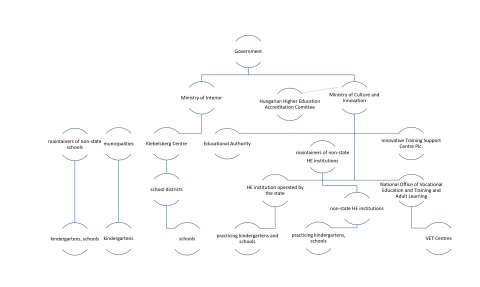The system of state
The structure of Hungary's state organisation, its administrative institutions and its system of governance developed after the democratic transition of 1989-90. The current legal system is governed by the Fundamental Law, which entered into force on 1 January 2012. It was preceded by the 1949 Constitution (significantly amended in 1989).
Hungary is a democratic republic governed by the rule of law. The head of state is the President of the Republic, who represents the unity of the nation and is the guardian of democracy.
According to the Fundamental Law, the Hungarian state functions on the basis of the principle of the separation of powers: the legislative power (the National Assembly), the executive power (the Government) and the judiciary (the courts and the prosecution) are separate.
Parliamentary elections take place every four years. Since 2014, elections have been a single round. The National Assembly has 199 members: 106 are elected in individual constituencies and 93 on national lists of candidates.
Hungarians living outside Hungary who also hold Hungarian citizenship have the right to vote. National minorities also have the opportunity to be represented.
Hungary is divided into the capital, counties, towns and villages. Districts may be formed in the capital and in the cities. Local public power is exercised by the municipalities. Municipal elections are held every five years, with mayors elected directly and local representatives elected from individual lists or a mixed system (individual and party lists).
The National Assembly
The National Assembly is the representative body of the people. Its main functions are to monitor the government and to make laws: any member of parliament can initiate a new law or an amendment to a law. To pass a law or amendment, half of the members of parliament must support it, except for cardinal laws and the Basic Law, which require the support of two-thirds of the members.
The Government
The Government exercises executive power: it issues decrees to implement laws and supervises and manages public institutions. Its members are the Prime Minister and the Ministers responsible for the various sectors, assisted by Secretaries of State.
Since March 2020, a special legal order has been in place to deal with various emergencies (COVID-19 pandemic, migration and then the Russian-Ukrainian war): the Government can overrule laws passed by the National Assembly by decree, i.e. it is a government by decree.
The governance of education
Two ministries are responsible for the governance of education in Hungary: the Ministry of Interior (Belügyminisztérium) for public education and the Ministry of Culture and Innovation (Kulturális és Innovációs Minisztérium) for vocational education and training, higher education and adult education.
The work of the ministries is supported by background institutions and intermediary bodies.
The Klebelsberg Centre (Klebelsberg Központ), under the Ministry of Interior, is responsible for coordinating the 60 local school district centres that run public education institutions and for ensuring a uniform quality in education. The coordination of public educational institutions that are not maintained by the state is carried out by separate maintenance organisations (e.g. churches, foundations).
Municipalities are responsible for maintening of nurseries and kindergartens.
The Educational Authority (Oktatási Hivatal) is responsible for tasks related to the administration of public education and higher education. As such, it falls under both the Ministry of Interior and the Ministry of Culture and Innovation. Its main tasks are the collection and management of data on education, the support and supervision of those involved in education and related processes (e.g. admission procedures, school-leaving examinations), the procedures for the establishment and authorisation of educational institutions, and the establishment, launching and supervision of education and training programmes. Its tasks also include the development of curricula and textbooks, the registration and naturalisation of language certificates and the recognition of qualifications and diplomas obtained abroad.
Background institutions supporting the tasks of vocational education and training and adult learning are under the Ministry of Culture and Innovation.
The National Office of Vocational Education and Training and Adult Learning (Nemzeti Szakképzési és Felnőttképzési Hivatal) is responsible for coordinating the maintenance of vocational education and training institutions through 41 VET Centres. It keeps the register of institutions, ensures the distribution of vocational training subsidies, helps with the recognition of domestic vocational qualifications abroad and supports professional examinations.
The Innovative Training Support Centre Plc. (IKK Innovatív Képzéstámogató Központ Nonprofit Zártkörűen Működő Részvénytársaság) supports the renewal of vocational education and training and adult learning as the centre for the professional methodology and examinations.
The Hungarian Accreditation Committee (Magyar Akkreditációs Bizottság) is the independent national body of experts responsible for quality assurance in higher education. Among its tasks, it accredits higher education institutions and their programmes, and gives expert opinions on applications for higher education teachers. The Minister responsible for higher education exercises a regulatory control over the activities of the Committee.
There are 64 state-recognised higher education institutions in Hungary. They can be funded by public trusts, churches, the state (ministry) or private enterprises.
| The Governance of Education |

|
